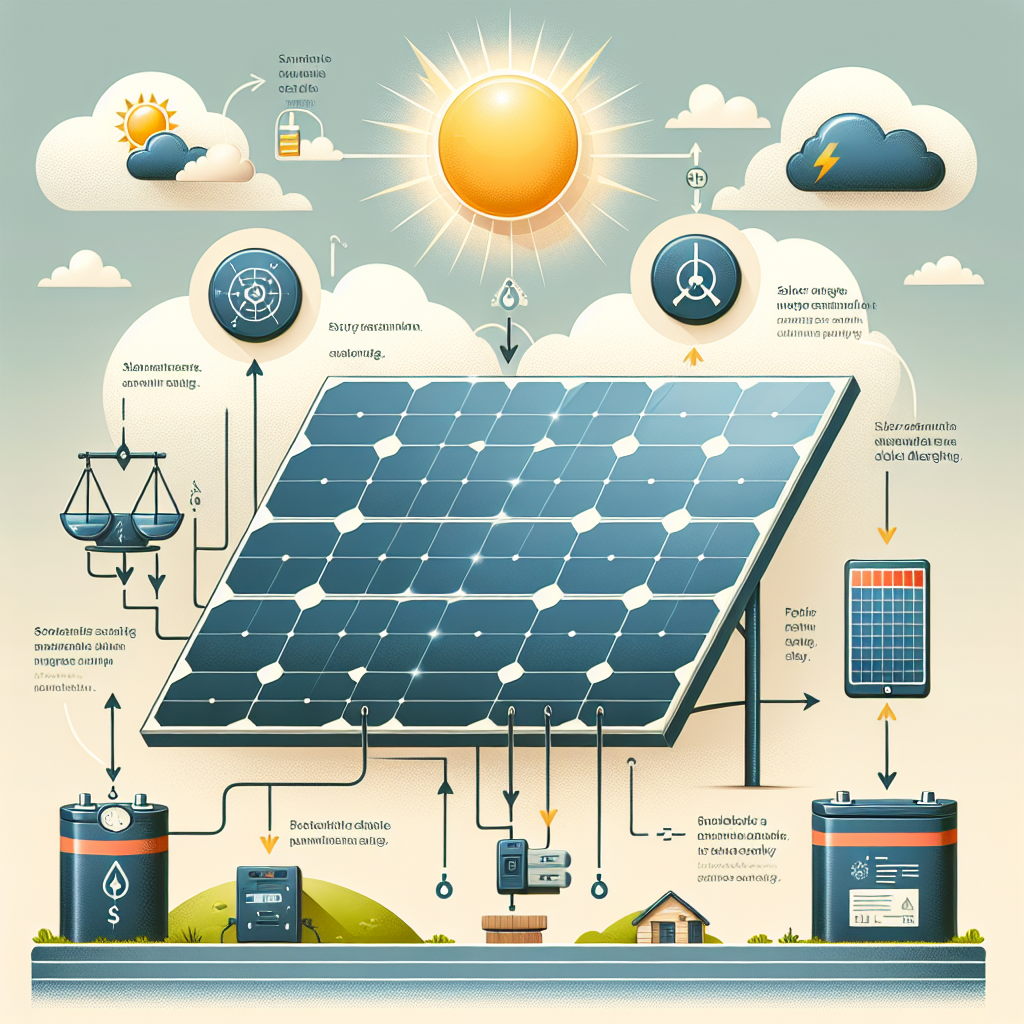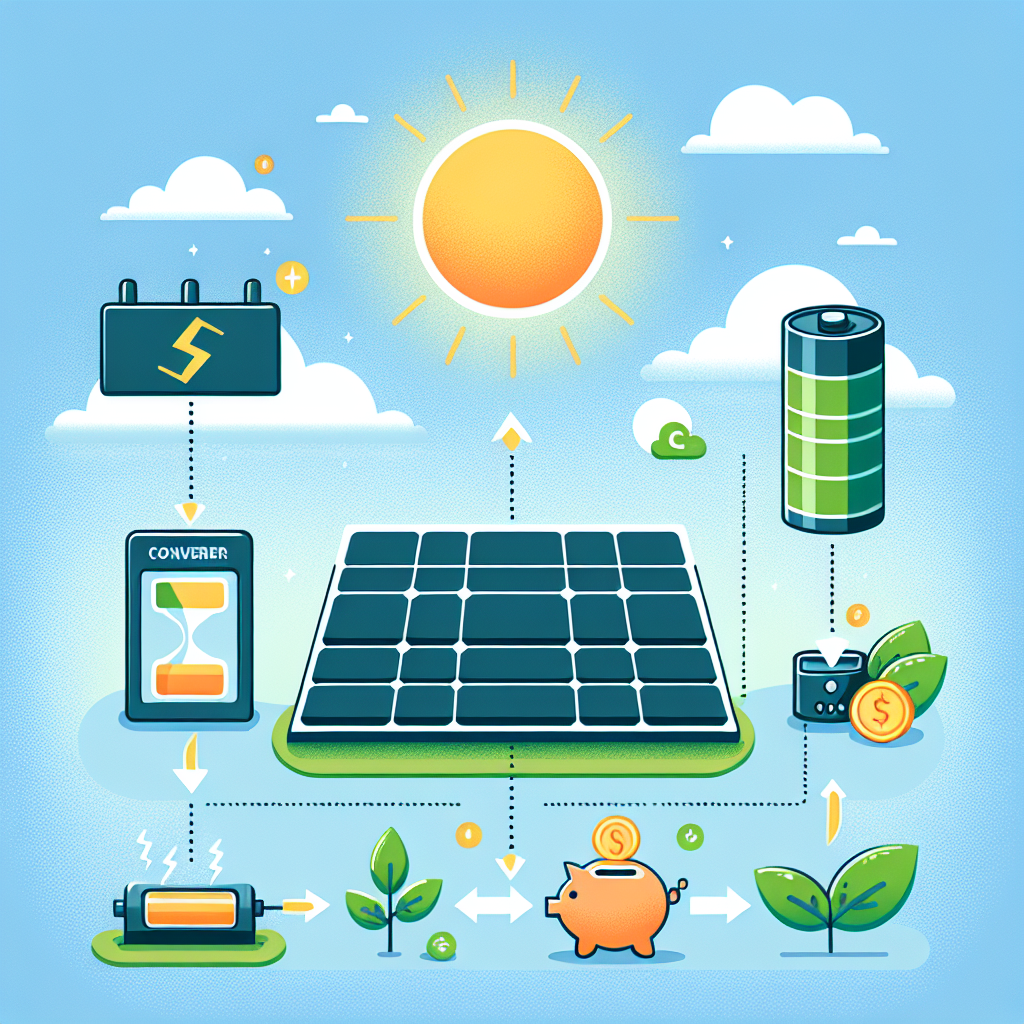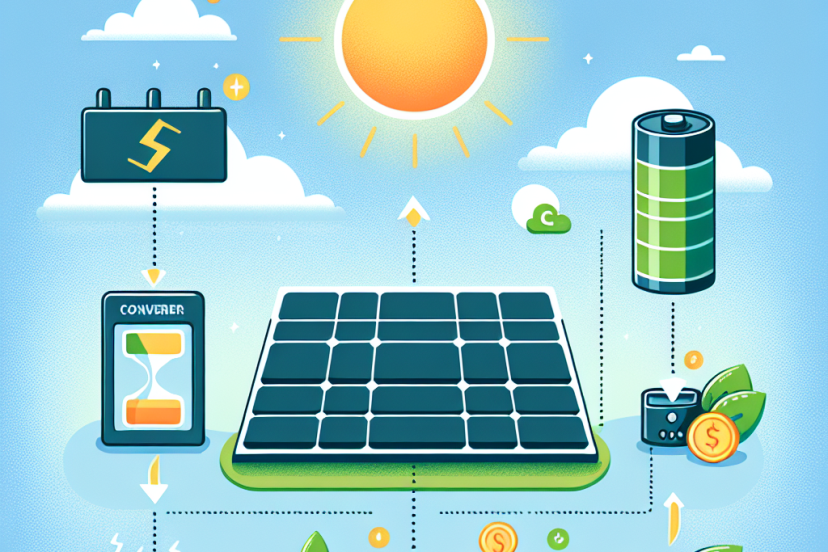How To Charge A Battery From Solar Panel
As an Amazon Associate, I earn from qualifying purchases, at no additional cost to you. Disclaimer
Hey there! Today, I wanted to talk about a topic that I find quite fascinating – how to charge a battery from a solar panel. With the growing popularity of renewable energy sources, harnessing the power of the sun to charge batteries has become a convenient and eco-friendly alternative. Whether you’re an avid camper, someone looking to reduce their electricity bill, or simply interested in sustainable energy solutions, learning how to charge a battery from a solar panel can be incredibly useful. Not only will this article provide you with step-by-step instructions, but it will also share some tips and tricks to optimize the process. So, let’s get started on this exciting journey into the world of solar-powered battery charging!
Understanding Solar Energy Basics
Solar energy is a renewable and sustainable source of power that harnesses the energy emitted from the sun. It is a clean and abundant source of energy that can be used to generate electricity, heat water, and power various electronic devices. The principle behind solar energy conversion involves the utilization of solar panels to absorb sunlight and convert it into electricity through a chemical process called photovoltaic (PV) effect. This process enables the direct conversion of sunlight into electrical energy.
What is Solar Energy
Solar energy refers to the radiant energy emitted by the sun, which can be converted into various forms of usable energy, such as electricity and heat. It is a renewable source of power that does not deplete natural resources and does not result in harmful emissions. Solar energy is harnessed using solar panels, which consist of numerous photovoltaic cells that convert sunlight into electricity. By utilizing this abundant and clean energy source, individuals and businesses can reduce their reliance on fossil fuels and contribute to a greener and more sustainable future.
Principle of Converting Sunlight into Electricity
The principle behind converting sunlight into electricity lies in the photovoltaic effect. When sunlight strikes the solar panels, the photons in the sunlight excite the electrons in the photovoltaic cells. This excitation creates an electric current, which can be harnessed and stored in batteries for later use. The electrical current generated by the solar panels is direct current (DC), which needs to be converted into alternating current (AC) for most household appliances. This conversion is achieved by using an inverter, which converts the DC electricity into AC electricity suitable for powering various devices and appliances.
Advantages of Solar Energy
Solar energy offers numerous advantages over traditional energy sources, making it an increasingly popular choice for both residential and commercial applications. The key advantages of solar energy include:
- Renewable and Sustainable: Solar energy is derived from the sun, which is an infinite source of energy. As long as the sun continues to shine, solar energy will be available for harnessing.
- Environmentally Friendly: Solar energy is a clean and green energy source that does not produce harmful emissions or contribute to air pollution and climate change.
- Cost-effective: By investing in solar panels and harnessing solar energy, individuals and businesses can significantly reduce their electricity bills, leading to long-term cost savings.
- Energy Independence: Solar energy allows for greater energy independence, as it reduces reliance on the grid and provides a reliable source of power even in remote areas without access to electricity.
- Low Maintenance: Solar panels require minimal maintenance and have a long lifespan, making them a hassle-free energy solution.
How Solar Panels Work
Solar panels, also known as photovoltaic panels, are made up of numerous solar cells that convert sunlight into electricity. These solar cells are typically made of silicon, which is a semiconductor material. When sunlight strikes the solar panels, it excites the electrons within the silicon atoms, creating an electric current. The solar cells are arranged in a grid, with each cell connected to form a panel. Multiple panels can be combined to meet the desired power output.
The electricity generated by the solar panels is in the form of direct current (DC). To power household appliances and devices that require alternating current (AC), an inverter is needed to convert the DC electricity into AC electricity. The AC electricity can then be used directly or stored in batteries for later use during periods of low sunlight or at night.
Components Required for Charging a Battery from Solar Panel
To charge a battery from a solar panel, several components are required to ensure efficient and safe operation. These components include:

Solar panels
Solar panels are the most crucial component when it comes to harnessing solar energy for battery charging. The number and size of solar panels needed depend on the desired power output and the amount of sunlight available. It is important to choose high-quality solar panels with efficiency ratings and durability to maximize energy production.
Batteries
Batteries are essential for storing the electricity generated by the solar panels for later use. Deep cycle batteries, such as lead-acid or lithium-ion batteries, are commonly used for solar energy storage. The capacity and voltage rating of the batteries should be selected based on the energy requirements and the duration of backup power needed.
Charge Controller
A charge controller regulates the flow of electricity from the solar panels to the batteries. It prevents overcharging and ensures proper charging and discharging cycles, thereby prolonging the battery’s lifespan. Charge controllers come in various types, such as PWM (Pulse Width Modulation) and MPPT (Maximum Power Point Tracking), each with its own advantages and suitable applications.
Inverter
An inverter converts the direct current (DC) electricity from the batteries into alternating current (AC), which is required to power most household appliances and electronic devices. The size and capacity of the inverter should be determined based on the anticipated power consumption and the maximum load it can handle.

Wires and Connectors
Wires and connectors are necessary for interconnecting the solar panels, batteries, charge controller, and inverter. High-quality and properly sized wires should be used to minimize power loss and ensure efficient energy transfer. Connectors, such as MC4 connectors, allow for easy and secure connections between the components.
By utilizing these components in a well-designed solar energy system, efficient battery charging can be achieved, providing a reliable and sustainable source of power.
Choosing the Right Solar Panel
When selecting solar panels for battery charging, there are several factors to consider to ensure optimal performance and efficiency. These factors include:
Type of Solar Panels
Solar panels are available in various types, including monocrystalline, polycrystalline, and thin-film panels. Each type has its own advantages and limitations, such as efficiency, cost, and aesthetics. Monocrystalline panels are known for their high efficiency, while polycrystalline panels are more affordable. Thin-film panels are lightweight and flexible, making them suitable for certain applications.
Factors to Consider While Purchasing Solar Panels
- Efficiency: The efficiency of a solar panel refers to how effectively it converts sunlight into electricity. Higher efficiency panels generate more electricity from the same amount of sunlight, making them more desirable. However, higher efficiency panels often come at a higher cost.
- Durability: Solar panels should be able to withstand various weather conditions and have a long lifespan. Look for panels with sturdy construction, weather-resistant materials, and warranty coverage to ensure longevity.
- Size and Power Output: Consider the available space for installation and the required power output to determine the number and size of solar panels needed. Solar panels with higher wattage ratings produce more electricity, but they may require more space.
- Brand and Reputation: Choose reputable brands and manufacturers known for their quality and reliability. Read customer reviews and seek recommendations to make an informed decision.
Recommended Solar Panels for Battery Charging
Some popular and well-regarded solar panel brands for battery charging applications include SunPower, LG, Canadian Solar, and Panasonic. These brands offer a range of high-efficiency panels with excellent durability and performance. However, it is important to assess individual requirements and consult with solar energy professionals to determine the best solar panel choice for specific battery charging needs.

Selecting the Appropriate Battery
Choosing the right battery for a solar panel system is crucial for efficient energy storage and reliable battery charging. There are several types of batteries typically used in solar energy systems, including:
Types of Batteries
- Lead-Acid Batteries: These are the most commonly used batteries in solar energy systems. They are affordable but have a limited lifespan and lower depth of discharge compared to other battery technologies.
- Lithium-Ion Batteries: Lithium-ion batteries offer higher energy density, longer lifespan, and deeper discharge capabilities compared to lead-acid batteries. While they are more expensive, their performance and durability make them a suitable choice for many applications.
- AGM (Absorbent Glass Mat) Batteries: AGM batteries are a type of lead-acid battery that uses a glass mat separator to hold the electrolyte. They provide better vibration resistance, lower self-discharge rates, and require less maintenance compared to traditional flooded lead-acid batteries.
Factors to Consider While Choosing Batteries
- Capacity: The capacity of the batteries dictates how much energy can be stored. It should be selected based on the anticipated energy consumption and the duration of backup power needed.
- Voltage Rating: Batteries are available in different voltage ratings (e.g., 12V, 24V, 48V). The voltage rating should match the requirements of the inverter and other components in the system.
- Lifespan: Consider the expected lifespan of the batteries, as this will impact their long-term cost-effectiveness. Lithium-ion batteries generally have a longer lifespan compared to lead-acid batteries.
- Depth of Discharge: The depth of discharge (DoD) is the amount of capacity that can be utilized before recharging the battery. Higher DoD batteries provide more usable energy but may be more expensive.
Recommended Batteries for Solar Panels
For solar panel battery charging systems, deep cycle batteries are recommended due to their ability to withstand repetitive deep discharges. Some popular deep cycle battery brands include Trojan, Renogy, VMAXTANKS, and Battle Born Batteries. Depending on the specific requirements and budget, lead-acid or lithium-ion deep cycle batteries can be chosen to ensure efficient battery charging and storage.
Importance of Charge Controller
A charge controller plays a crucial role in maintaining the proper charging and discharging cycles of the batteries, ensuring their longevity and optimal performance. It serves several functions to regulate the flow of electricity between the solar panels and the batteries.
Functions of a Charge Controller
- Overcharging Protection: The charge controller prevents the batteries from overcharging, which can lead to reduced battery life and potentially damage the battery.
- Battery Voltage Regulation: The charge controller monitors the battery voltage and regulates the charging current accordingly to maintain the batteries at their optimal voltage.
- Load Control: Some charge controllers have built-in load control features, allowing them to manage the output to power connected loads directly or activate a backup power source when needed.
- Temperature Compensation: Advanced charge controllers have temperature sensors that adjust the charging process based on variations in temperature, optimizing battery performance.
Types of Charge Controllers
- PWM Charge Controllers: Pulse Width Modulation charge controllers are cost-effective and suitable for smaller solar energy systems. They regulate the charging current by rapidly switching the solar panel’s output on and off to maintain the battery voltage.
- MPPT Charge Controllers: Maximum Power Point Tracking charge controllers are more advanced and efficient. They use a dynamic algorithm to continuously track the maximum power point of the solar panels, extracting the maximum energy even under variable weather conditions.
Choosing the Right Charge Controller
When selecting a charge controller for a solar battery charging system, consider the following factors:
- Voltage Compatibility: Ensure that the charge controller’s voltage range matches the system’s voltage, including the solar panel and battery voltage ratings.
- Current Capacity: The charge controller should have the capacity to handle the maximum current output of the solar panels.
- Advanced Features: Advanced charge controllers offer additional features such as data monitoring, programmability, and remote monitoring capabilities. Assess the need for these features based on the system requirements.
Consulting with solar energy professionals or referring to reputable manufacturers’ recommendations can help choose the most suitable charge controller for a solar battery charging system.

The Role of an Inverter in Charging Battery
An inverter plays a pivotal role in charging batteries by converting the direct current (DC) output from the batteries into alternating current (AC).
Understanding the Need for an Inverter
Most household appliances and electronic devices operate on AC electricity, making an inverter an essential component for utilizing the stored energy efficiently. The inverter not only converts the current but also provides stable and clean AC power, ensuring compatibility with a wide range of devices and appliances.
Types of Inverters
- Stand-Alone or Off-Grid Inverters: These inverters are used in standalone solar energy systems where the energy generated by solar panels is solely used to power the connected loads and charge the batteries.
- Grid-Tied Inverters: Grid-tied inverters are designed to work in conjunction with a utility grid. They convert the DC power from the batteries into AC, which can be used to power the loads as well as supply excess electricity back to the grid.
- Hybrid Inverters: Hybrid inverters combine the functionalities of both stand-alone and grid-tied inverters. They allow for grid-tied operation while also providing backup power during grid outages.
Inverter Selection Criteria
When selecting an inverter for a solar battery charging system, consider the following criteria:
- Power Output: Determine the maximum power output requirement based on the connected loads and appliances. The inverter should have sufficient capacity to handle the peak power demand.
- Voltage Compatibility: Ensure that the inverter’s input and output voltage ratings match the battery and load requirements.
- Waveform: Inverters can produce either pure sine wave or modified sine wave output. Pure sine wave inverters provide clean and stable power, suitable for most devices. Modified sine wave inverters are more affordable but may cause compatibility issues with certain devices.
- Efficiency: Consider the inverter’s efficiency rating, as a higher efficiency translates to less energy waste and more effective utilization of the stored battery power.
- Additional Features: Some inverters offer built-in features such as battery monitoring, power factor correction, and surge protection. Evaluate these additional features based on the system’s requirements.
Proper research, consultation with professionals, and reviewing product specifications can guide the selection of the most suitable inverter for a solar battery charging system.
Procedure for Connecting Solar Panel to Battery
Connecting a solar panel to a battery involves several steps to ensure safe and efficient operation. It is important to follow the correct procedure to avoid damage to the components and ensure optimal performance. Here is a step-by-step guide:
Step 1: Positioning the Solar Panels
Install the solar panels in a location that receives maximum sunlight exposure throughout the day. Choose a spot with minimal shading from surrounding objects or structures. Position the panels at an optimal angle to maximize solar energy capture.
Step 2: Mounting the Solar Panels
Securely mount the solar panels on a sturdy structure or rooftop, ensuring they are not exposed to extreme vibrations or environmental hazards. Use appropriate mounting brackets and hardware to ensure stability and durability.
Step 3: Installing the Charge Controller
Connect the charge controller to the solar panels, battery, and load. Follow the manufacturer’s instructions to ensure proper wiring and connections. Pay attention to the polarity and use appropriate wiring methods to minimize power loss.
Step 4: Connecting the Battery
Connect the battery to the charge controller, following the correct polarity. Ensure a secure and clean connection using appropriate terminals and connectors. Implement safety precautions such as using insulated tools and wearing protective gloves to prevent electrical hazards.
Step 5: Inverter Connection
If using an inverter, connect it to the battery’s DC output, following the specified voltage and wiring requirements. Ensure tight and reliable connections to prevent power loss and potential damage to the inverter.
Step 6: System Testing
After the connections are made, carefully inspect all wiring and connections for any signs of damage or loose connections. Double-check the system’s settings, such as charge controller parameters and inverter configurations, to ensure they align with the battery and load requirements.
Safety Precautions
- Before connecting or disconnecting components, ensure that the solar panels are not exposed to sunlight.
- Turn off any connected loads before making any adjustments or connections to prevent electrical shocks.
- Handle electrical connections with caution, wearing appropriate safety gear and using insulated tools.
- Follow the manufacturer’s instructions and safety guidelines when working with electrical components.
Resolving Common Connectivity Issues
In case of connectivity issues or malfunctions, it is important to troubleshoot and resolve them promptly. Some common connectivity issues include loose connections, faulty wiring, and incorrect polarity. Check all connections, ensure proper wiring, and verify the polarity. If the issue persists, consult with professionals or refer to manufacturer guidelines to diagnose and resolve the problem.

Maintenance of Solar Panel and Battery
Proper maintenance of solar panels and batteries is essential for their longevity and optimal performance. Regular cleaning, inspection, and preventive measures can minimize potential issues and ensure efficient operation.
Cleaning and Inspection of Solar Panels
- Regularly clean the surface of the solar panels to remove dirt, dust, and debris that can reduce their efficiency. Use water and a soft cloth or a brush specifically designed for solar panels. Avoid using abrasive materials or harsh chemicals that can damage the panels.
- Periodically inspect the panels for any signs of physical damage, such as cracks or corrosion. Check the wiring and connections for any loose or damaged parts. Address any issues promptly to prevent further damage.
Battery Maintenance Tips
- Keep the battery in a cool and well-ventilated location to prevent overheating. Extreme temperatures can adversely affect the battery’s performance and lifespan.
- Regularly inspect the battery for any signs of leakage, corrosion, or physical damage. Check the terminals and connectors for tightness and cleanliness.
- Ensure that the battery is properly charged and discharged regularly to prevent sulfation and stratification. Follow the manufacturer’s recommendations for charging and discharging cycles.
- If using lead-acid batteries, periodically check and refill the electrolyte levels, if applicable. Handle battery maintenance with caution, following proper safety guidelines.
Replacing Faulty Components
If any components, such as solar panels, batteries, charge controllers, or inverters, display signs of irreparable damage or malfunction, it is important to replace them promptly with suitable replacements. Consult with professionals or refer to manufacturer guidelines to select and install compatible components. Improper replacement can risk system efficiency and safety.
Monitoring and Improving the Efficiency of Your Solar System
Monitoring the performance of a solar system and implementing strategies to improve its efficiency can maximize energy production and optimize battery charging. Here are some key considerations:
Interpreting Power Output Readings
Regularly monitor the energy output of the solar panels using a monitoring system or a solar power meter. Analyze power output trends to identify any discrepancies or inefficiencies. Compare the actual output with the expected output based on sunlight exposure and other factors. Deviations may indicate issues such as shading, wiring problems, or insufficient energy capture.
Strategies for Optimizing Solar Capture
- Maintain the cleanliness of the solar panels to ensure maximum sunlight absorption.
- Optimize the positioning and angle of the solar panels to align with the sun’s path.
- Consider using solar tracking systems that adjust the panels’ orientation automatically for optimal solar capture throughout the day.
- Minimize shading by trimming trees or adjusting nearby structures if necessary.
Upgrading Your Solar Charging System
As technology evolves, upgrading your solar charging system can improve its efficiency and performance. Consider the following upgrades:
- Upgrading to more efficient solar panels: Higher efficiency panels can generate more electricity from the same amount of sunlight, maximizing energy output.
- Installing additional solar panels: Increasing the number of panels can enhance energy capture and charging capacity.
- Upgrading to advanced charge controllers or inverters: Advanced controllers and inverters can provide better performance, monitoring capabilities, and compatibility with new technologies.
- Adding energy storage solutions: Incorporating advanced battery technologies, such as lithium-ion batteries, can enhance energy storage capacity and efficiency.
Consult with solar energy professionals to assess the feasibility and benefits of upgrading your solar charging system based on specific needs and budget considerations.
Benefits and Limitations of Charging a Battery from Solar Panel
Charging a battery from a solar panel offers numerous benefits, but there are also limitations and challenges to consider.
Energy Independence and Savings
Charging a battery from a solar panel provides energy independence by reducing reliance on the grid. This offers greater control over energy consumption and costs. Solar energy is a free and renewable resource, allowing for potential long-term savings on electricity bills. The stored energy in the battery can be used during power outages or during peak demand periods, further reducing dependence on the grid.
Environmental Impact
Charging a battery from a solar panel significantly reduces reliance on fossil fuels and decreases carbon emissions. Solar energy is clean, produces no greenhouse gases, and has a minimal environmental impact. By adopting solar charging systems, individuals and businesses contribute to mitigating climate change and preserving the environment.
Limitations and Challenges
- Dependency on Sunlight: Solar panels rely on sunlight to generate electricity, making them less effective during cloudy days or in areas with limited sunlight exposure.
- Initial Cost: The upfront cost of installing a solar charging system can be high, including the costs of solar panels, batteries, inverters, and other components. However, long-term savings from reduced electricity bills may outweigh the initial investment.
- Space Requirement: Solar panels occupy space and may require a dedicated location for installation. Sufficient space is needed to accommodate the desired number of panels and ensure optimal energy capture.
- Maintenance: Although solar panels and batteries require minimal maintenance, periodic cleaning, inspection, and potential component replacements are necessary to ensure optimal performance and longevity.
Overcoming Common Barriers
Overcoming the limitations and challenges of solar charging systems can be achieved through various measures:
- Implementing energy storage solutions: Incorporating advanced battery technologies enhances energy storage capacity and minimizes the impact of intermittent sunlight availability.
- Utilizing grid-tied systems: Grid-tied solar systems provide the ability to export excess electricity back to the grid, ensuring a continuous power supply during low sunlight periods.
- Government Incentives and Support: Many governments offer incentives, tax credits, and support programs to promote renewable energy adoption. These incentives can help offset the initial installation costs and promote the use of solar charging systems.
By understanding and addressing these limitations and challenges, individuals and businesses can overcome barriers and embrace the benefits of charging a battery from a solar panel, contributing to a greener and more sustainable energy future.

